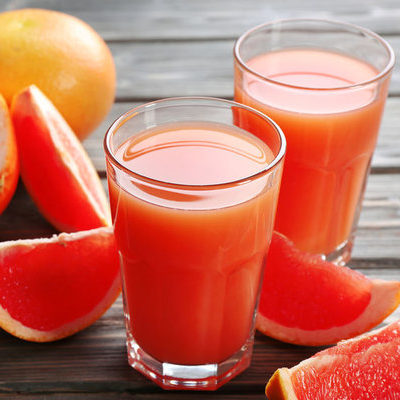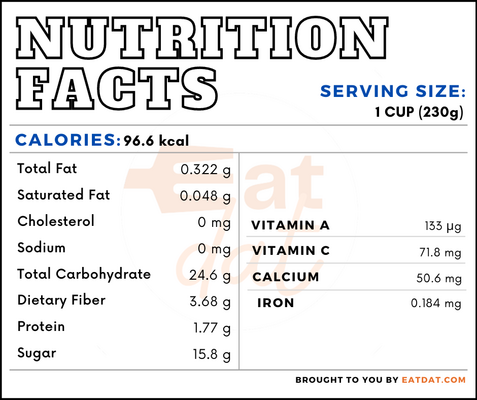
Grapefruit Juice
What is Grapefruit Juice?
Grapefruit juice is the liquid extract from grapefruits and can be sweet, tart, or sour. The grapefruit is a citrus fruit that has a soft flesh-like an orange and juicy interior, which is segmented. It is called a grapefruit because it appears in clusters on the tree, similar to grapes. Different variations of this juice include:
- white
- pink
- ruby red
Ripe fruits are required for making juice, which can be made at home or store-bought. The average per capita consumption in the US is 0.2 liters, though its popularity is decreasing.
According to Serious Eats, the top 8 juice brands on the market are:
- Whole Foods
- Trader Joe’s
- Tropicana
- Natalie’s Orchid Island Juice Company
- Simply Juice
- Ocean Spray
- Florida’s Natural
- Apple and Eve
Origin of grapefruit juice
The grapefruit is a hybrid between the pomelo and the orange. However, in 1837, it was classified as a pomelo variety. It was only in 1949, more than a century later, that botanists discovered the truth. This fruit is a native fruit of Barbados, and was first recorded by Europeans in 1750, who called it the “forbidden fruit”.
Count Odette Phillipe took seeds from this fruit to Florida, where grapefruit trees grew in abundance. In 1870, John MacDonald established the first nursery in the US. The Ruby Red cultivar was created in Texas when a citrus grower discovered a red grapefruit growing on a pink grapefruit tree in 1929. By 1940, the United States was exporting close to 11,000,000 cases of juice. Juice consumption in the US also increased during this time. Today, this juice is a popular beverage.
Nutrition
One cup (230g) of grapefruit juice contains:

Grapefruit juice is low in calories and also has a low glycemic index, which makes it suitable for diabetes patients. It also contains naringin, a flavonoid which improves glucose tolerance in people with diabetes. This juice is filled with nutrients such as calcium, magnesium, phosphorus, potassium, folate, choline, beta carotene, and lycopene. It also contains good amounts of vitamins A and C. All these nutrients are helpful in maintaining heart and skin health, as well as preventing strokes and some types of cancers.
However, mixing grapefruit juice with certain drugs should be avoided. It inhibits a chemical in the intestine needed to break down many pharmaceutical drugs in the body. These include medications for regulating blood pressure, suppressing the immune system, sedatives, and AIDS medicines. Steroids and asthma medicines may also be harmful, if taken with this juice.
Commercial production
The commercial production is similar to the juicing of other citrus fruits. It begins with the selection of ripe grapefruits that are treated, pressed to extract the juice, and filtered before being pasteurized and packaged. However, one issue surrounding the commercial production is the presence of naringin. This flavonoid lends a bitter and unpleasant taste, thereby posing an important economic challenge in the commercial production of this juice. This is usually dealt with by using enzymatic debittering technology.
Grapefruit juice recipes
This juice can be consumed as a beverage or in different dishes. This juice can be used for marinating meats, cheeses, and vegetables. It is also handy in making syrups and sauces. The addition of grapefruit juice in cooking imparts a mildly sweet taste to the dish. It can even be used to make curd or cocktails. Here are a few recipes that use grapefruit juice:
- Greek Yogurt Cake
- Ruby Red Grapefruit Bars
- Pound Cake
- Green Smoothie
- Paloma
- Meringue Pie
- Marmalade
- Quinoa and Salmon Salad
- Soy Sauce and Citrus Marinated Chicken
FDA regulations
The FDA defines grapefruit juice as the unfermented juice obtained from ripe grapefruits and intended for direct consumption. The juice must not contain seeds, peel, or excessive pulp. Grapefruit juice must have at least 10 percent concentration.
References
Morton, J. 1987. Grapefruit. p. 152–158. In: Fruits of warm climates. Julia F. Morton, Miami, FL.
https://hort.purdue.edu/newcrop/morton/grapefruit.html
Wang, Chung-Yi et al. “Quality changes in high hydrostatic pressure and thermal pasteurized grapefruit juice during cold storage.” Journal of food science and technology vol. 55,12 (2018): 5115-5122. doi:10.1007/s13197-018-3452-z
https://www.ncbi.nlm.nih.gov/pmc/articles/PMC6233445/
Should you avoid grapefruit juice? Harvard Health Publishing, Harvard Medical School
https://www.health.harvard.edu/drugs-and-medications/should-you-avoid-grapefruit-juice
